Where we are able to identify a network of urban commons, or some degree of polycentricism in the governance of urban resources, we begin to see the transformation of the city into a commons—a collaborative space—supported and enabled by the state.
Cities and many kinds of urban commons are different from natural resources and more traditional commons in important ways. For this reason, we have surveyed 100+ cities around the world and many examples of urban commons within them. From this study, we have extracted a set of design principles for governing urban commons and cities as commons. And we are creating a website as a resource and open platform to which additional data, or case studies, can be added as we become aware of them.
The results of our research will soon be available on a digital platform. Our intention is that www.commoning.city will become an international mapping platform and open collaborative dataset for the urban commons and for cities that want to embrace a transition towards the commons paradigm. The goal of this research project is to enhance our collective knowledge about the various ways to govern urban commons, and the city itself as a commons, in different geographic, social and economic contexts. The case studies, both community-led and those that are institutionalized or “nested” in the local government, are important data points and empirical input into the larger effort to explicate the dynamic process (or transition) from a city where urban commons institutions are present to one where we see the emergence of networked urban commons.
Ostrom’s design principles need to be adapted for the urban context
In our work we have asked whether the commons can be a framework for addressing a host of internal and external challenges facing cities. More specifically, can designing the city as a commons help us address issues such as urban poverty, gentrification, climate change, migration, among others? Can the Ostrom design principles help cities to transition to more fair, inclusive, sustainable, resilient futures given existing patterns of urbanization and the contested nature of urban resources such as public spaces, open or vacant land, abandoned and underutilized structures, and aging infrastructure? In our study, we will see examples of how these resources can be governed as a commons in cities around the world. Moreover, we extract from these examples a set of design principles that are distinctively different from those offered by Elinor Ostrom.
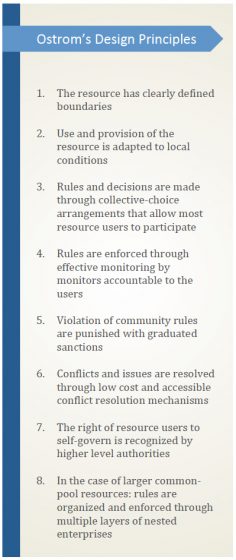 Ostrom’s study focused mainly on close knit communities in which it was clear who was from the place and who was not (principle 1). For these communities, social control/monitoring and social sanctioning were two central pillars of Ostrom’s design principles for the governance structure that communities would put in place to manage a common pool resource (principles 5 and 6). For this reason, she thought rules of cooperation among users should be written or modified by those who would be entrusted with both the duty to obey to them and the responsibility to enforce them (principle 3).
Ostrom’s study focused mainly on close knit communities in which it was clear who was from the place and who was not (principle 1). For these communities, social control/monitoring and social sanctioning were two central pillars of Ostrom’s design principles for the governance structure that communities would put in place to manage a common pool resource (principles 5 and 6). For this reason, she thought rules of cooperation among users should be written or modified by those who would be entrusted with both the duty to obey to them and the responsibility to enforce them (principle 3).
The fact that these rules would be written by the same community of users that would apply them led to the need to leave some room for adaptation of such rules to local needs and conditions (principle 2). Of course, these structures and rules would be based on the idea that these communities right to self-govern the resource would be recognized by outside authorities (principle 4).
Ostrom realized, however, that for more complex resources this governance responsibility or power should be shared with other actors to form nested enterprises (principle 8). Notwithstanding the above, she anticipated that conflicts might arise because even the most united communities would have internal fractions and therefore require accessible, low cost tools to solve their own disputes (principle 7). These are the basic design principles which for years have been driving the study and observation of common, shared resources—namely scarce, congestible, renewable natural resources such as rivers, lakes, fisheries, and forests.
To say that the city is a commons is to suggest that the city is a shared resource—open to and shared with many types of people. In this sense, the city shares some of the classic problems of a common pool resource—the difficulty of excluding people and the need to design effective rules, norms and institutions for resource stewardship and governance. It is tempting, therefore, to impose Ostrom’s design principles onto the city and to apply them to the management of many kinds of public and shared resources in the city. For many reasons, however, Ostrom’s ideas cannot be used in the city the way they were in the nature. Ostrom’s framework needs to be adapted to the reality of urban environments, which are already congested, heavily regulated and socially and economically complex. Without such adaptation, Ostrom’s design principles will be lost in translation.
This is why, starting ten years ago, we both began to explore the governance of the urban commons as a separate body of study (first investigating individually how different kinds of urban assets, urban public space such as community gardens and urban infrastructure such as urban roads, could be reconceived as urban commons, and later jointly to conceive the whole city as a commons). We realized that we needed a different approach to bridge urban studies and commons studies and therefore to pose a slightly different set of questions for governance of the urban commons. We also needed to define a different set of design principles for the commons in the city and the city itself as a commons.
Designing and constructing commons in the city
Cities and many kinds of urban commons are different from natural resources and more traditional commons in important ways. First, cities are typically not exhaustible nor nonrenewable, although they can become quite fragile over time due to internal and external threats. Much of the city consists of urban infrastructure—open squares, parks, abandoned buildings, vacant lots, roads—which can be purposed and repurposed for different uses and users. These resources share very little with the forests, underwater basins and irrigation systems that were the subject of Elinor Ostrom’s study of common pool resources.
Second, cities are what we might call “constructed” commons, the result of emergent social processes and institutional design. The process of constructing a commons—what some refer to as “commoning”—involves a collaborative process of bringing together a wide spectrum of actors that work together to co-design and co-produce shared, common goods and services at different scales. They can be created at the scale of the city, the district, the neighborhood, or the block level.
Third, cities do not exist in a pre-political space. Rather, cities are heavily regulated environments and thus any attempt to bring the commons to the city must confront the law and politics of the city. Creating urban common resources most often requires changing or tweaking (or even hacking, in a sense) the regulation of public and private property and working through the administrative branches of local government to enable and/or protect collaborative forms of resource management. Legal and property experimentation is thus a core feature of constructing different kinds of urban commons.
Fourth, cities are incredibly complex and socially diverse systems which bring together not only many different types of resources but also many types of people. Because of this diversity and the presence of often thick local (and sublocal) politics, social and economic tensions and conflicts occur at a much higher rate and pace than many natural environments. The economic and political complexity of cities also means that governance of urban commons cannot be just about communities governing themselves. Rather, collective governance of urban commons almost always involves some forms of nested governance, and in most cases cooperation with other urban actors.
New design principles for the urban commons
Based on these differences, we began to think anew about design principles for the urban commons, taking into account what Ostrom learned about successful governance of natural resources commons. While many of her principles have clear applicability to constructed urban commons—such as recognition by higher authorities (principle 7), the importance of nestedness for complex resources (principles 8), the existence of collective governance arrangements (principle 3), and resource adaptation to local conditions (principle 2)—others are of limited utility or need to be adapted to the urban context.
For instance, communities should drive, manage, and own the process of governing shared urban resources, but we have seen time and time again that they can rarely avoid dealing with the state and the market. While this can be true of natural commons, and rural communities, we think both the state and the market are even more omnipresent in cities, making it difficult to side step them over the long run. As such, we observe that many types of urban commons tend to benefit from cooperation with other than internal community members and resource users. Rather, they need to collaborate and pool resources with other commons-minded actors like knowledge institutions and civil society organizations.
We have observed that in contexts where the State is the strongest, and markets are not as strong, local and provincial government actors can lend assistance to, and form a solid alliance with, communities to advance collective governance of urban resources. In this sense, the State generally acts as an enabler of cooperation and pooling of resources and other actors.
On the other hand, where the State is weak or weaker, either because of corruption or lack of resources, strange enough the market seems to be the only answer to enable the pooling of resources (i.e. human, economic, cognitive, etc.) needed for collective action and collaborative management or urban resources. The market could subsidize the commons if proper legal structures and participatory processes are put in place and there is sufficient social and political capital among resource users to negotiate with market actors.
In both cases, the concept of “pooling” seems to capture the true essence of commons-based projects and policies in the urban environment. For these reasons, we have identified in our work two core principles underlying many kinds of urban commons as an enabling state and pooling economies.
We also observed for instance that technology in cities plays a key role in enabling collaboration and sustainability, as well as pooling users of urban assets, shared infrastructure, and open data management. Further, urban commons-based governance solutions are cutting-edge prototypes and therefore need careful research and implementation. In other words, they are experimental; new approaches and new methodologies are constantly being developed and require prototyping, monitoring and evaluation.
These basic empirical observations are now the cornerstone of a much larger and scientifically driven research project that we established and call the “Co-Cities Project”. The Co-Cities Project is the result of a 5-year effort to investigate and experiment with new forms of collaborative city-making that is pushing urban areas towards new frontiers of participatory urban governance, inclusive economic growth and social innovation. The project is rooted in the conceptual pillars of the urban commons.
The idea of the “Co-City” is based on five basic design principles, or dimensions, extracted from our practice in the field and the cases that we identified as sharing similar approaches, values and methodologies. While some of these design principles resonate with Ostrom’s principles, they are each adapted to the context of the urban commons and the realities of constructing common resources in the city. We have distilled five key design principles for the urban commons:
- Principle 1: Collective governance refers to the presence of a multi-stakeholder governance scheme whereby the community emerges as an actor and partners up with at least three different urban actors
- Principle 2: Enabling State expresses the role of the State in facilitating the creation of urban commons and supporting collective action arrangements for the management and sustainability of the urban commons.
- Principle 3: Social and Economic Pooling refers to the presence of different forms of resource pooling and cooperation between five possible actors in the urban environment
- Principle 4: Experimentalism is the presence of an adaptive and iterative approach to designing the legal processes and institutions that govern urban commons.
- Principle 5: Tech Justice highlights access to technology, the presence of digital infrastructure, and open data protocols as an enabling driver of collaboration and the creation of urban commons
These design principles articulate the types of conditions and factors necessary to instantiate the city as a collaborative space in which various forms of urban commons not only emerge but are sustainable. The concept of the co-city imagines the city as an infrastructure on which participants can share resources, engage in collective decision-making and co-production of shared urban resources, supported by open data and guided by principles of distributive justice. A co-city is based on polycentric governance of a variety of urban resources such as environmental, cultural, knowledge and digital goods that are co-managed through contractual or institutionalized public-private-community partnerships. Polycentric urban governance involves resource pooling and cooperation between five possible actors—social innovators, public authorities, businesses, civil society organizations, and knowledge institutions. These collaborative arrangements give birth to local peer-to-peer production of experimental, physical, digital and institutional platforms with three main aims: fostering social innovation in urban welfare provision, spurring collaborative economies as a driver of local economic development, and promoting inclusive urban regeneration of blighted areas. Public authorities play an important enabling role in creating and sustaining the co-city. The ultimate goal of a co-city is the creation of a more just and democratic city, also in light of the Lefebvrian approach of the right to the city.
The Co-Cities report and dataset
As part of the Co-Cities project, in collaboration with organizations like IASC, P2P Foundation, DESIS and key figures in the commons debate, we have been engaged in organizing and participating in scientific conferences, as well as identifying and evaluating commons-based projects and policies in European and American cities (where we have both worked) and in different geopolitical contexts. We have built thus far a dataset of more than 100 cities, which we surveyed over 18 months (from December 2015 to June 2017), and from which we have summarized more than 200 examples of urban commons projects and/or public policies from observed cities. The case studies we gathered come from different kinds of cities located all around the world, and include groundbreaking experiments in which we have been involved in Bologna and Turin (Italy), as well as those taking place in other Italian cities (e.g. Naples, Milan, Rome, Palermo, Bari, etc.). Our studies of various kinds of urban commons include global cities such as Seoul (South Korea), San Francisco (USA), Madrid and Barcelona (Spain), Amsterdam (Netherlands), Athens (Greece), Nairobi (Kenya), Medellin (Colombia), Bangalore (India) and many other cities (see the map below).
Among the better known recent examples considered by the scope of our research are the FabCity transition plan towards re-localized and distributed manufacturing, the Superblocks initiative, the Reglamento De Participación Ciudadana and the many other initiatives taken by the new Mayor of Barcelona, Ada Colau; the Bologna and Turin Regulation on Civic Collaboration for the Urban Commons; San Francisco, Seoul and Milan initiatives to transform themselves into “sharing cities”; Edinburgh and Glasgow as “cooperative cities”; and Naples’ regulation on urban civic uses.
The results of our research are discussed in a co-cities report to be released early in the Fall 2017 which aims to develop a common framework and understanding for “urban (commons) transitions.” These transitions include: patterns, processes, practices, and public policies that are community-driven and that position local communities as key political, economic and institutional actors in the delivery of services, production, and management of urban assets or local resources. The project focuses on emerging urban innovations and evolutions that are reshaping urban (and peri-urban) development and land use, urban and local economic patterns, urban welfare systems and democratic and political processes, as well as governmental decision-making and organization. Where we are able to identify a network of urban commons, or some degree of polycentricism in the governance of urban resources, then we can confidently begin to see the transformation of the city into a commons—a collaborative space—supported and enabled by the state.
From these examples, we have extracted the above described recurrent design principles and have identified common methodological tools employed across the globe and for different urban resources and phenomena. The report uses case studies to map where urban commons innovations are occurring, analyzes the features of each individual case, and presents the testimony of leaders or key participants in the case studies. One of the main goals in interviews with participants and leaders is to discern whether the projects captured here represent isolated projects or whether they represent a city that is experiencing a transition toward a co-city. The ultimate objective of this report is to raise awareness about the commonalities among these case-studies and to serve as guidance for urban policy makers, researchers, urban communities interested in transitioning toward a Co-City.
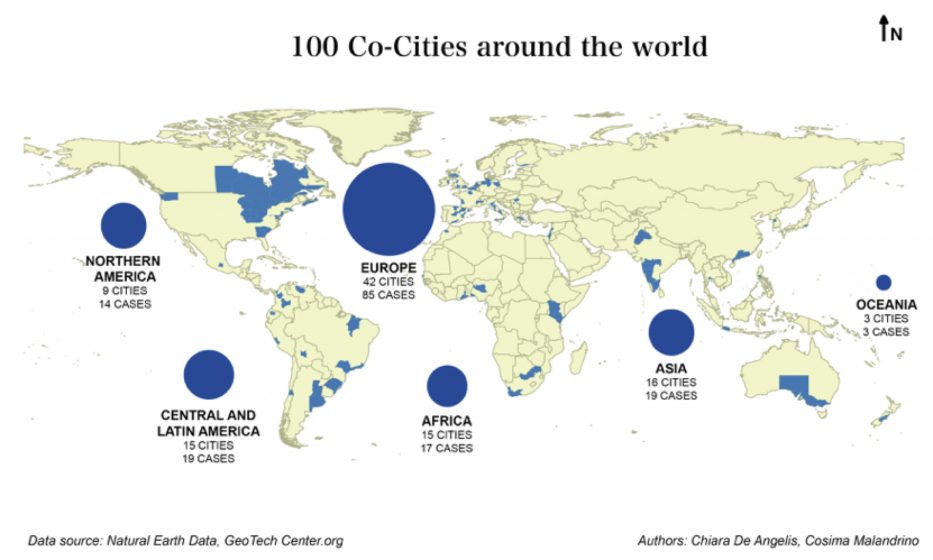

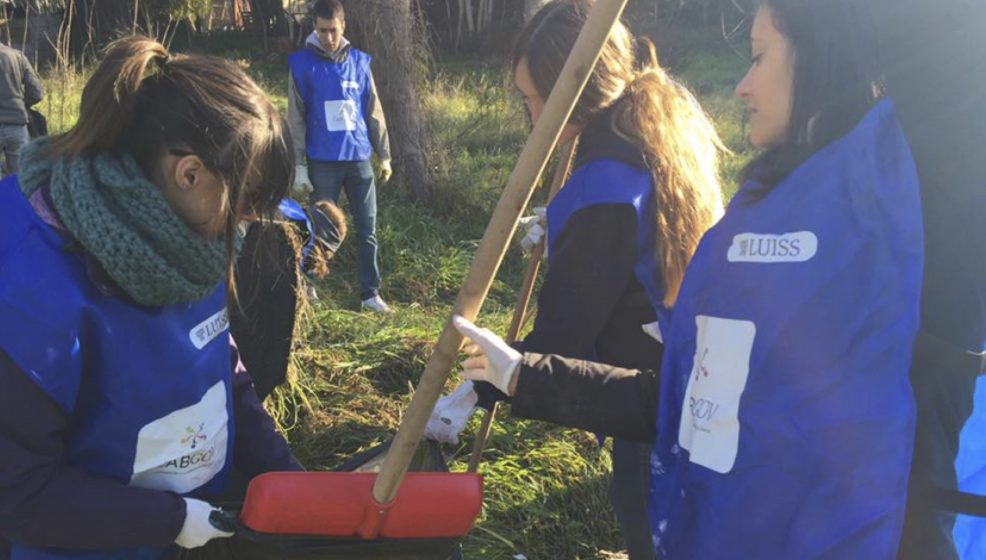
Conclusion: An action-based platform and research project on co-cities
The developing digital platform (www.commoning.city) will contain the results of our studies as well as a map of co-cities. The platform also brings together the contributions of several global thought leaders who have been developing and refining the ideas underlying the conceptual pillars of the Co-City. On this open platform, local practitioners, local officials, engaged residents and others are able to “map” themselves by completing a simple questionnaire (available in the “Map Your Project” section of the website). Once mapped on the platform, participants will then receive access to the dataset. Those who lead policies, projects or practices will receive the text of the in-depth interview, allowing them to explain the specifics of policy, project or practice as a way of being included in the co-cities research project. In return, those participants’ projects will be analyzed and evaluated according to the design principles set out above, as well as receive general guidance and feedback on the policy, project or practice.
We intend to use the platform also as a means to establish Co-City projects in different cities (including Amsterdam, New York City, Liverpool, Accra) as a way to engage directly in the implementation of the above design principles in different legal/economic systems. We also hope to demonstrate their applicability across contexts and the particular forms of adaptation required, particularly so that we can improve and revise the overall framework and design principles. Towards this end, we are looking to work with cities in South America, Asia, Oceania that want to establish the co-city project. The ultimate goal of the research is to co-develop and improve the quality of the theoretical framework and to build a co-cities index.
Sheila Foster and Christian Iaione,
New York & Rome
about the writer
Christian Iaione
Christian Iaione is associate professor of public law at Guglielmo Marconi University of Rome, fellow of the Urban Law Center at Fordham University, and visiting professor of governance of the commons at LUISS Guido Carli where he directs LabGov – LABoratory for the GOVernance of the Commons (www.labgov.it). He is member of the Sharing Economy International Advisory Board of the Seoul Metropolitan Government and advisor of several Italian local governments and institutions.


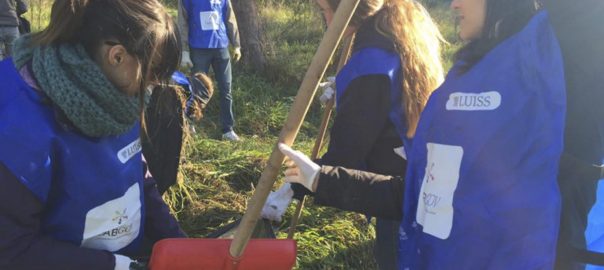
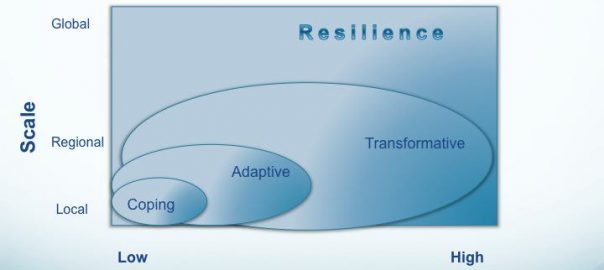



Leave a Reply